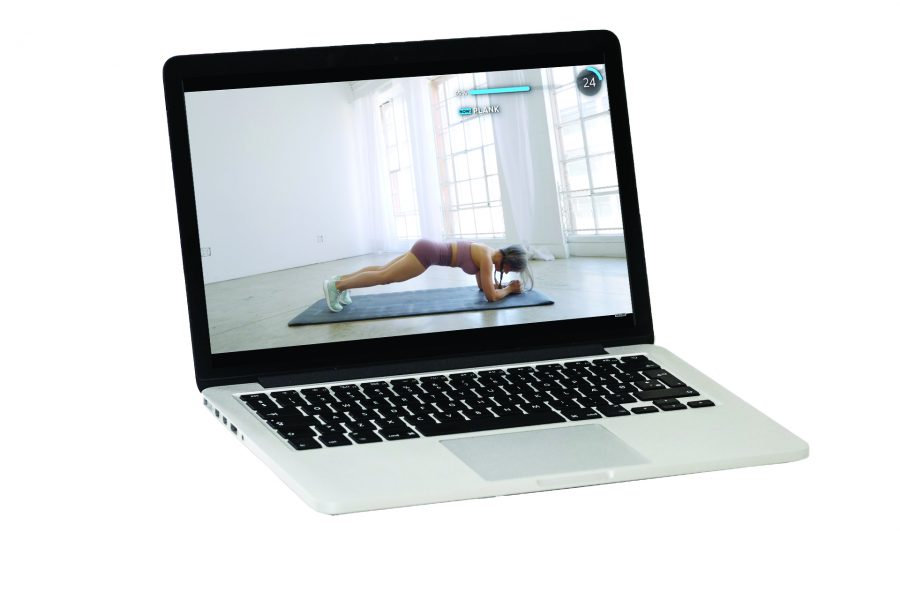“Your abs will love you and hate you at the same time,” Chloe Ting, a popular fitness influencer, said in a now viral workout video. Ting, a content creator with more than 15 million subscribers on YouTube, is known for her extremely popular workout challenges and body-transformational promises.
From March to May, Ting’s YouTube channel grew from fewer than 800,000 subscribers to more than 3 million, according to Social Blade. Ting’s subscriber boom is a direct reflection of the surge in fitness culture that has spread through social media during the pandemic.
As students made the unprecedented transition towards a predominantly virtual lifestyle, social media platforms became increasingly flooded with diet tips and workout routines. This pushed viewers to strive for society’s standard of a dream body during the free time they now possess. Feeling this added pressure, Gillian Keipp-Stroud ’22 said social media made her feel as though she had to maximize her newfound time.
“Everybody was posting about all the stuff they were doing and all the workouts and other things, and I just felt like if I wasn’t getting everything I wanted done, then I was lazy and wasting time,” Keipp-Stroud said.
Although people were pressured to be more productive at the beginning of the coronavirus pandemic, as weeks turned to months, Keipp-Stroud said the pressure shifted almost entirely to fitness and dieting.
“Basically, what I was seeing all over social media were challenges like the Chloe Ting Two Week Abs, where [Ting] said that if you did her ab workouts, you would get abs or a flat stomach in two weeks,” Keipp-Stroud said. “[I would see] TikToks that were saying, ‘get your butt big in five days,’ or ‘get your waist tiny,’ which is obviously not possible, but they make you think it is. My whole [TikTok feed] was full of ways to diet and get skinny.”
Keipp-Stroud was not alone.
Cassie* said that throughout the pandemic, she noticed an increase in fitness routine and dieting videos and the clear rise of diet culture in her TikTok feed.
“There was a certain period of time, around March, April and May, when my entire [TikTok] For You Page was entirely diet videos and working out videos, and that gave me a lot of anxiety,” Cassie said. “And there were just so many, and I couldn’t stop watching them.”
Cassie said the recent inundation of fitness culture throughout social media platforms puts a great deal of pressure to exercise and diet on many girls, including herself.
“I went through a period where I would work out like crazy,” Cassie said. “I was in my room, on my floor with a yoga mat, working out for like four hours a day. I was obsessed with it. But I found that every time I would finish [a workout challenge], and I would look in the mirror, I felt no different about myself. I felt sometimes worse about myself.”
Overall, Cassie said she feels that the fitness challenges, which are meant to inspire health and wellness, ultimately had the opposite effects on her.
“As a direct result of the challenges and everything I was putting myself through, I found that my mental health and body image were significantly worse than when I started,” Cassie said.
Like Cassie, Vita Saffari ’22 said interacting with fitness culture and participating in workout challenges resulted in a negative outcome for her. Saffari said she felt an overwhelming sense of discontent with any physical result of these workout challenges, especially with the addition of social media where other participants in fitness challenges are able to broadcast their results.
“Seeing those results kind of prolonged the toxic [mindset I had developed] with the Chloe Ting [challenges] because I remember just being very unhappy when I was doing it,” Saffari said. “Because you’re constantly analyzing yourself when you’re in these kinds of challenges, because you’re constantly looking for that end result, and you’re never going to get there because it’s always an unachievable goal.”
Interdisciplinary Studies and Independent Research Teacher and Head of Peer Support Tina McGraw said students must be careful when comparing their bodies to the ones they see on social media.
“The unrealistic and highly modified content on social media portrays a hyper-reality which isn’t representative of the way people look in reality,” McGraw said. “It’s extremely harmful to compare yourself to these doctored images.”
However, as someone who did compare herself to images shared on social media, Saffari said that for her, the discontent extended further than a simple workout routine. She said the pressure to lose weight coming from fitness and diet culture pushed her into patterns of restrictive eating.
“For me, everything went hand-in-hand,” Saffari said. “I was doing these fitness challenges and then ended up thinking that [losing weight] is 90% what you eat, and then I thought, ‘I have to change up what I eat.’ It was kind of a chain of events for me, and it was pushed along by the fact that I was seeing so many of these fitness videos on YouTube or on Instagram.”
Keipp-Stroud, who previously struggled with anorexia and bulimia, said the rise in fitness culture exacerbated a struggle she has faced since childhood.
“Ever since I was little, I used to count my calories and carbs, and [I] was always really self-conscious of looking different or bigger than the rest of my friends,” Keipp-Stroud said. “And I think when you do these challenges and workout and it doesn’t work, you think, ‘Okay, next step, food.’ You try to cut more calories or switch to only eating foods that TikTok told you would make you look a certain way.”
Mimi Offor ’21 said she recognizes that working out can be a healthy practice for people if they are motivated to participate in fitness challenges with honest motives, not to lose weight in accordance with traditional standards of beauty.
“It has to come from a positive place and not from a place of self-hate,” Offor said. “I just hope that anybody who’s doing a workout plan is doing it because they want to be healthy, and they love themselves and not because they think they need to change who they are to be beautiful.”
For young women like Saffari, who began fitness challenges due to the societal pressures created by traditional beauty standards, working out in this fashion can feel isolating. Saffari said having a space for girls who are also battling this isolation to confide in one another would have helped her greatly. She said that the best way for girls to get through the struggles of body-image is to uplift and be there for one another.
“I remember feeling really isolated and lonely by my problems, so I think as a community being there for each other would probably be the best way to support each other,” Saffari said. “I think having a support system to talk about these issues with other people, especially with girls and other girls [would have been helpful]. Because for me, it was really important for me to see myself in other people.”
*Names have been changed.











































